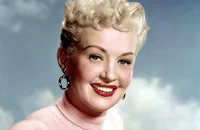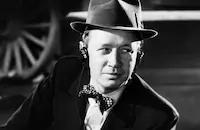Billy Rose's Diamond Horseshoe
Brief Synopsis
Cast & Crew
George Seaton
Betty Grable
Dick Haymes
Phil Silvers
William Gaxton
Beatrice Kay
Film Details
Technical Specs

Synopsis
One evening, medical student Joe Davis, Jr., visits his entertainer father at impresario Billy Rose's famous Diamond Horseshoe nightclub in New York City. After the show, Davis, Sr. is squabbling with singer Bonnie Collins, with whom he has a bitter rivalry, when he spots Joey. Although Davis is delighted to see Joey, he is disappointed when his son announces that he is giving up his studies to enter show business. Davis tries to explain the many difficulties of theater life, and in order to keep an eye on Joey, immediately arranges for him to work as an assistant to stage manager Blinkie Miller. Distraught over her argument with Davis, Bonnie then faints backstage and Blinkie asks Joey to examine her. Believing that Joey is a doctor, Bonnie is not perturbed when she discovers that he loosened her tight costume while she was unconscious. When she learns that he is Blinkie's new assistant, however, Bonnie assumes that he is not a doctor and slaps him for being fresh. A week passes as Joey learns his job and tries to date Bonnie, who gives him the cold shoulder. When Blinkie hears Joey sing, though, he realizes that Joey has real talent and offers to take him to the Footlight Club, where he can sing with the band. After the show at the Diamond Horseshoe, Joey and Blinkie leave for their evening out, while Bonnie returns home, where her roommate and fellow performer, Claire Williams, is packing her belongings. Claire explains that Davis, to whom she is engaged, has ended their relationship so that he can devote himself exclusively to Joey. Knowing that Bonnie covets her mink coat, Claire offers to give it to her if she will get Joey to leave town by pretending to fall in love with him and then dump him. Reluctantly agreeing, Bonnie accompanies Claire to the Footlight Club, where she listens to Joey sing and begins to charm him. Impressed by Joey's good nature, Bonnie has second thoughts about tricking him, but a dream about fur coats convinces her to continue. Bonnie goes with Joey on a picnic the next day, and when she sighs over luxurious items such as furs and yachts, Joey relates his theory that women who want fur coats are sublimating their desire for a husband. Bonnie is infuriated by Joey's psychology lessons, but falls in love with him as they spend more time together. Joey does not tell Davis about the romance, but he discovers it himself when he finds the couple in a nightclub. Bonnie leaves so that Joey can talk to his father, and Davis advises him to break up with Bonnie, whom he considers to be a gold digger. Joey storms out and Davis then confronts Bonnie. She states that she loves Joey and that Davis should not try to push his son into medicine if he truly wants to be a singer, but when Joey saves the life of a man suffering from insulin shock, Bonnie realizes that Davis is right about where Joey's true talent lies. Hoping to encourage Joey to return to medical school, Bonnie turns down his marriage proposal, telling him that he will have to be a success in show business before she will marry him. When he sees her toss away Claire's mink coat, however, he realizes that she truly loves him. They are soon married, and a furious Davis demands that Bonnie be fired from the Diamond Horseshoe. Six months pass as Joey tries unsuccessfully to break into show business. Concerned, Bonnie consults his psychology textbook and tells him that his attempt to become a singer is an unconscious effort to prove himself to his father. Joey finally admits that he misses medicine, and when he receives a favorable response to his most recent audition, Bonnie tells him that if he persists with show business instead of returning to school, he will do it without her. Another six months pass, and back at the Diamond Horseshoe, Davis complains to Blinkie about Bonnie's replacement, just as he used to complain about Bonnie. Blinkie then takes Davis to a nightclub to hear a "new" singer, and has to stop Davis from walking out when he recognizes Bonnie. Blinkie explains that Bonnie has been working night and day to support Joey, who has begun his residency at a nearby hospital. Touched by Bonnie's devotion to Joey, Davis quits the Diamond Horseshoe and arranges for Bonnie to be rehired. On Bonnie's opening night, Blinkie schemes to have Davis replace the new leading man during the finale. Davis' sincere apology wins Bonnie over, and as they sing together, they are joined onstage by Joey and Claire.

Director
George Seaton
Cast

Betty Grable

Dick Haymes

Phil Silvers
William Gaxton

Beatrice Kay
Carmen Cavallaro
Willie Solar

Margaret Dumont
Roy Benson
George Melford
Hal K. Dawson
Kenny Williams
Reed Hadley

Eddie Acuff
Edward Gargan
Ruth Rickaby
Dorothy Day
Dick Elliott
Harry Seymour
Phil Tead

Julie London
Virginia Walker
Donald Hayden
Ronnie Ralph
Bobbie Hale
Irving Gump
Milt Kibbee

Lee Phelps
Marguerite Blount
John Ardell
Charles Cane
Bob Reeves
Frank Fanning
Alex Melesh
Arthur Foster
Jean Fenwick
Evan Thomas
Ferdinand Munier
Eric Wilton
Paul Bakanas
Charles Coleman

Bess Flowers
Louis Payne
Herbert Heywood
Bruce Warren
Frank Scannell
Gwen Donovan
Frank Penny
Bud Jamison

Ray Teal
Ed Laughton
Phyllis Kennedy
Gladys Gale
Cyril Ring
Crew
Sascha Brastoff
Lew Brown
Ernie Burnett
Bonnie Cashin
Russ Cheever
Sidney Clare
Walter Donovan
Arthur Fields
Leo Friedman
Mack Gordon
Ralph O. Hammeras
Roger Heman
Charles Henderson
Renè Hubert
Richard Irvine
Artie Jacobson
Natalie Kalmus
Lou Kunkel
Ernest Lansing
Charles Lemaire
Thomas Little
Junie Mccree
Richard Mueller
Kay Nelson
Alfred Newman
George A. Norton
Ben Nye
Ernest Palmer
Hermes Pan
William Perlberg
Billy Rose
George Seaton
Fred Sersen
Robert Simpson
Herbert Spencer
Murray Spivack
Vinton Vernon
Albert Von Tilzer
E. Clayton Ward
Harry Warren
Lyle Wheeler
Beth Slater Whitson
Joseph C. Wright

Film Details
Technical Specs

Quotes
Trivia
Notes
Several contemporary and modern sources refer to this film as Diamond Horseshoe. According to information in the Twentieth Century-Fox Records of the Legal Department, located at the UCLA Arts-Special Collections Library, entertainment entrepreneur Billy Rose sold Twentieth Century-Fox the rights to use the name of his famed nightclub, The Diamond Horseshoe, for this film for $75,000. Rose (1899-1966) began his career as a lyricist, then became a successful producer of Broadway plays in 1930. Rose also owned and operated several theaters and restaurants. The legal files note that Rose agreed to act as consultant on the picture, and the studio was allowed to use any costume sketches, production designs, scripts of shows, dance routines and musical compositions that were featured in the nightclub, as well as to recreate the nightclub itself. The legal records indicate that Rose had also negotiated with independent producer Jack H. Skirball for the rights, but decided to sell to Twentieth Century-Fox upon receiving written assurances that William Perlberg would produce the picture, George Seaton would write it and Betty Grable would star in it. The film marked Seaton's directorial debut. Although a October 25, 1943 Hollywood Reporter news item mentioned a "possibility of Rose himself playing in the film," Rose does not appear in the picture, nor does an actor portray him. Several times during the film, characters mention that Rose is out of town working on other projects.
Although a July 1944 Hollywood Reporter news item stated that "fifteen-year-old lyric soprano" Hazel Dawn [later known as Hazel Dawn, Jr.] had been signed for a "featured role," her appearance in the completed film has not been confirmed. In addition to the songs listed above, "The Old and the New Way" production number includes portions of the following songs: "Sleep, Baby, Sleep," "Shoo-Shoo Baby," "Mairzy Doats" and "Flat Foot Floogie (with the Floy Floy)." An August 1944 Hollywood Reporter news item noted that "My Heart Is Young," a song written by actress Beatrice Kay and her husband, Sylvan Green, would be sung in the picture, but it does not appear in the finished film. Songwriter Harry Warren was borrowed from M-G-M for the production, which marked Grable's return to the screen after a one-year maternity leave. According to a May 1945 Hollywood Reporter news item, Hugh Harman Productions filed a lawsuit alleging "breach of contract and failure to perform" against Twentieth Century-Fox for "repudiating a contract to include an animation sequence" in the picture. The disposition of the suit has not been determined.
In 1928, First National Pictures produced a film with a musical score and sound effects based on the same source, entitled The Barker, directed by George Fitzmaurice and starring Milton Sills, Douglas Fairbanks, Jr. and Dorothy Mackaill (see AFI Catalog of Feature Films, 1921-30; F2.0270). In 1934, Fox released Hoop-La, which was also based on John Kenyon Nicholson's play. Hoop-La was directed by Frank Lloyd and starred Clara Bow and Preston Foster (see AFI Catalog of Feature Films, 1931-40; F3.1986).












